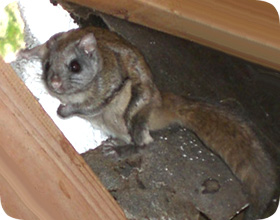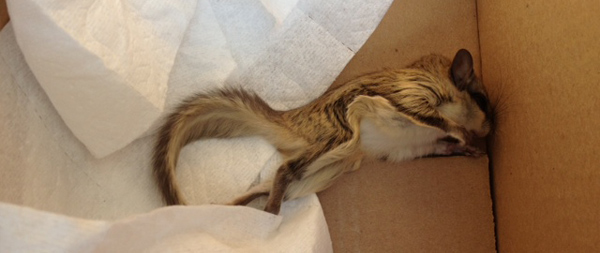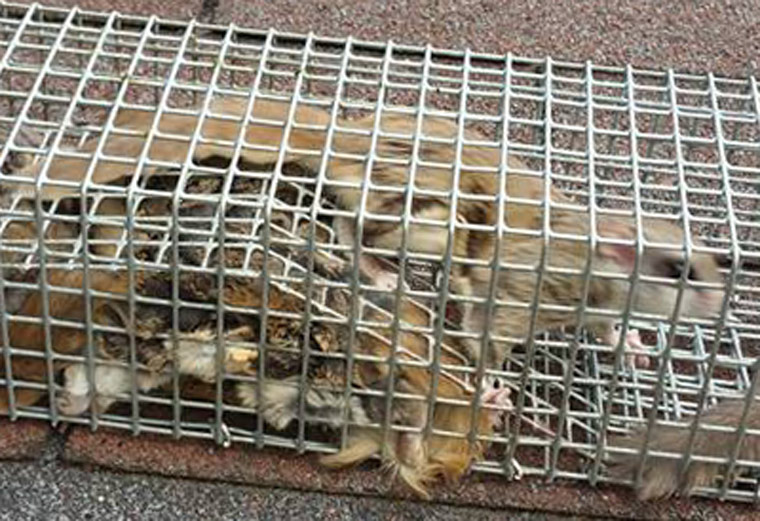- info@wildlife-removal.com
Call us for help in your town
Wildlife Removal Education
How To Get Rid Of Flying Squirrels
Need squirrel removal in your hometown? We service over 500 USA locations! Click here to hire us in your town and check prices - updated for year 2020.
 Flying Squirrels are usually classified as a pest species because they love to live in buildings, they are nocturnal, and they live in colonies of several animals. Read more about flying squirrels. The most common complaints include the following:
Flying Squirrels are usually classified as a pest species because they love to live in buildings, they are nocturnal, and they live in colonies of several animals. Read more about flying squirrels. The most common complaints include the following:
- Scurrying in attic or walls at night
- Odor from large colony in house
- Chewing on wood outside home
- Chewing on wires in attic
Need professional help? Click here for my Nationwide List of Flying Squirrel Trappers
How To Get Flying Squirrels Out Of The Eaves or Ceiling
Flying squirrels are some of the greatest spectacles that you can see in nature. To see them gliding from tree to tree is one of the most impressive and underrated shows. You will have a hard time meeting someone who does not become enamored of the sight; even people who would otherwise seem to have a heart of stone will smile while looking at these animals. The awe and admiration of the flying squirrel however ends when one of them makes its way inside your residence.
The ceiling is one of the most common places that a flying squirrel may see as a home. It is dry, it has low human traffic and it protects from the cold. An attic also provides a great place to hide for a squirrel. The eaves of a house unfortunately is also probably the most difficult place to get the flying squirrel because of its size, speed and the fact that it has several places to hide. Chances are that you will hear the flying squirrel, but it will go into hiding the moment it hears you coming. So the best way to get a flying squirrel out of your attic is a humane trap. These traps will not only catch the squirrel quickly, they will also do it humanely. You will then search for any areas it entered through and seal these off.
How To Get Rid Of Flying Squirrels In Your House
Just like a regular squirrel, a flying squirrel is very fast and if you have no idea how to get them out they will give you one of the biggest wildlife challenges that you will ever come across. Because there are different locations in your residence that a flying squirrel can get to, there are also different techniques that you should use to get them out. Some of the things that you can do in the living room will not work in the attic, so here are some of the best techniques that you can use.
If the squirrel has gone into the house (not in the attic) then the technique is a lot simpler. If you open a door, in addition to windows and remove their screens, chances are that the flying squirrel will leave right away. They do not like to be in the same house as humans, so if they see a chance to escape they will take it. If the squirrel goes into hiding in a corner instead of escaping then you should get a thick blanket, and throw it on top of the squirrel. Once the blanket is on top of the squirrel, pick it up and take it outside. It is also a great idea to wear gloves in addition to using the blanket. Do not pick up a squirrel with your bare hands because they can carry disease, so even if they don’t bite, you can end up with a problem. Read the guide Can You Use Repellent to Remove Flying Squirrels from the Attic?.
How To Get Rid Of Flying Squirrels In An Apartment
An apartment gives you a smaller space to work with if you are trying to catch a squirrel. You should try the same technique as you would in a house. Open the door or a window to encourage the squirrel to leave when it sees freedom so close. This will work almost every time and if it does not you should try the trapping technique, but be especially careful in an apartment, because generally your space is smaller. The squirrel will have nowhere to go and depending on where your door is you may have to plan to carry the squirrel outside and fast. Having the door opened before you catch the squirrel is a good idea. Live traps are the best method but you can use towels and gloves to capture the animal as well.
How To Get Rid Of Flying Squirrels In A Building
Getting a squirrel out of a building can be a bit tricky because in most cases it can be difficult to find the squirrel. You should look for signs that a squirrel may have left in order to find out where it is hiding. Sometimes you will find droppings or signs of food or entry. There are a lot of places where a squirrel can hide so be thorough.
Look in places that are warmer than others in the winter and places where there may be access to the outside of the building. This is a situation that is best for live traps. You do not have to worry about the squirrel going into hiding because the trap works when you are not there. You use bait that squirrels like such as unsalted nuts or peanut butter. With some luck you will trap the squirrel within a few hours. You should let a day pass by before you check the trap, because if you keep coming back to check on it a squirrel may decide to stay into hiding even if the bait is there. Follow this advice and you will be able to trap a flying squirrel quickly.
Visit Flying squirrels in attic and Flying squirrel removal as well.
Ways to Get Rid of Flying Squirrels
Flying squirrels are naturally adapted to living around trees in forest, but due to urbanization and the consequent lack of sufficient trees on which they can thrive, they are gradually finding shelter in and around human houses. They are known to make their nests in attics, vents, gutters, and the likes. Another reason for their seeking human abodes is to find food. Being omnivores, flying squirrels are able to feed on anything that humans eat. As such, they can perfectly adapt to living with humans.

There are various ways to get rid of flying squirrels, and they include fencing them out, excluding them, catching or killing them with traps, repairing homes to prevent them from coming in, repelling them with repellents and so on.
Exclusion
This is done with exclusion traps, which are set at the entrance and exit points of any place where the flying squirrels are nesting. Flying squirrels are nocturnal, so they will leave at night to forage and once they leave this nesting site via the exclusion trap, they will be unable to re-enter when they return. At this point, they would be forced to find another nesting site in the area.
Home repairs
There has to be an opening before a flying squirrel, or indeed other animals, can get inside a house. These openings may have been made by other animals or may be the result of cracks in the building itself. To be completely rid of flying squirrels, you must keep them out by blocking every opening that they can enter through. This also applies if you have just removed them from your property; it is the only way to be free of these gliding animals because other methods will only get rid of existing ones, and not prevent others from entering. The holes should be sealed with durable materials like concrete or wire mesh so the seal does not get chewed out. Read the guide Can Flying Squirrels Chew Through Your Wood or Electrical Wires?
Trapping
Live trapping is the way to go when you need to get rid of flying squirrels that have invaded your house or barn. The cage traps are available at animal control stores, but the success of these catch traps in catching flying squirrels depends on the right usage. There are various types of live traps to choose from, some of which are the colony humane live traps, multiple catch traps and live single door traps. Whatever live trap you choose, the wire spacing must not be more than 1/2 inch by 1/2 inch, else these small animals can escape from the trap. Read the guides Best Ways to Trap or Exclude Flying Squirrels and Ways to Tell if There is A Flying Squirrel in Your Attic.
Colony humane live traps are placed in front of the holes through which the flying squirrels exit and enter their abode, this way they are forced into the trap. Live single door traps are to be set near their holes or inside the attic itself if the holes cannot be reached or seen. With multiple catch traps, the flying squirrels enter through one door and are unable to escape, wander into the second door trying to escape, and on into the back door, where they are hidden until set free.
Bait your live traps with seeds, fruits, vegetables, bread with peanut spread on it etc. The bait should be placed both inside and outside of the traps, this will help to lure them in.
After successfully catching them, transport them far away from your property so they cannot return. Or take them to a wildlife location if one is available around you. However, it is always advisable to wear hand gloves and be careful when handling flying squirrels because they are also carriers of some disease.
Use of repellents
There are a handful of repellent products that are aimed at scaring flying squirrels away, but they hardly give the desirable results. Most of them do not get rid of the animals at all, and those that do, only temporarily. Mothballs (also called naphthalene), predator urine, ammonia and ultrasonic sound emitters are some of the commonly used repellents.
Killing
As a last resort, you may consider killing these flying squirrels either by poisoning or the use of lethal traps. While killing may effectively get rid of flying squirrels, it is not a humane way to go about it, and it has got several risks attached to it. Read the guide How can You Kill A Flying Squirrel?
Lethal body grip traps for instance, are set at the entrance hole and baited with their food. As soon as the animal walks into the trap, it gets killed instantly, after which you deal with the carcass.
Electronic traps work similarly. It is also set over the entrance of the flying squirrel hole, and whenever one ventures out and touches the trap, it gets electrocuted. Watch out though, so the traps don’t get a neighbourhood pet instead.
As for poisons, rodenticide is an anticoagulant that causes internal bleeding and eventually kills the flying squirrel. Poisons are however risky because untargeted animals may come across the poisoned food before the flying squirrel does, and be killed. Domestic cats for instance.
It is always a better idea to exclude flying squirrels, or fence them out, block all their points of entry, and trap then with live traps, rather than poisoning or killing them with lethal traps.
Getting Rid of Flying Squirrels
Live trapping and releasing of flying squirrels is actually a very bad idea, despite sounding like the most humane approach. To start with, animals that have been released into brand new and unknown territories usually die quickly. They don't know where to find the staple things in order to stay alive — food, water, shelter. They will be more vulnerable and, therefore, more likely to fall prey to attacks from predators. Open spaces will make them easy pickings from owls, eagles, hawks, and other large birds. There are plenty of predators on the ground too, and some of them can even climb trees to go after the flying squirrel, like raccoons. Without food, water, and the company of its friends and family members, that flying squirrel will soon run out of strength to run away or defend itself, and that's before you look at the toll that stress can take on any animal, humans and wild creatures alike.

All of these reasons aside, releasing a flying squirrel will probably result in that animal getting back to your home before you do. This is, again, something that can be said for a wide range of wild critters that you might choose to take the same approach with.
A male flying squirrel can have a home range of up to 16 hectares, which is the equivalent of 160000 square meters. That's just the range they hang out in — their territory, of sorts. They have an amazing homing ability, especially the Southern flying squirrel, and you would need to travel some distance before you released them. We're talking miles upon miles upon miles, and even then, it might not be enough. When you dump these animals somewhere they've never been before, they have nothing to lose in trying to get back home. They are probably going to die either way.
So, that's live cage trapping out the way, what about kill trapping?
Before you take any lethal action against the flying squirrel, you must work out what species or subspecies it is. You must handle the situation with care, hiring a professional so hat the animal can be excluded, rather than handled or killed. Exclusion devices work for a vast number of animals, including bats and flying squirrels. One-way doors are one of the most population options, but funnel style exclusion devices can be used. These should be created and used with caution, however, as they can easily go wrong.
These one-way door devices and traps allow the flying squirrel to exit the hole, but then, once they are out, the door is sealed shut. Other flying squirrels in the hole can still get out, but once they're out, they're out; the door simply doesn't move in the opposite direction.
There is a good chance that the flying squirrel will try to find its way back into the house, and that's why you should perform a sealing mission as well as your exclusion trap installations. The traps need to be installed on the commonly used holes, with the other, smaller, lesser-used ones sealed up with something that is gnaw-proof. All squirrels, just like all rodents, can chew, and it won't take them long to get back in.
Alongside your exclusion devices, you could look at repellents and deterrents to help the process along, but many of them simply do not work. They definitely do not work when you use them as you're only flying squirrel removal method. As soon as you stop using them, the squirrels have nothing to be deterred by and if you haven’t sealed up those holes, the squirrel will just come right back. So will many others — these don't often come alone.
Repellents can come in many forms. The simplest option (and one you should use regardless) is to remove the food source. When they don't have anything to eat, it's amazing how fast these critters can scamper off.
You may also want to look at using moth balls, although these can be toxic, contaminating soil and water sources, as well as actually killing certain species. Spray deterrents come in a range of forms also, from hot and pepper-based concoctions that you can make yourself at home, to wildlife eviction fluid, containing secretions and other bodily fluids from predator animals, such as raccoons, foxes, and coyotes. If it rains, you water your garden or back yard, or after the repellent has naturally worn away, you will need to reapply it. If you are buying quite an expensive product, the cost, over a long period of time, can start to mount up. When you look at how much it would have cost to hire in a professional in the first place, you might start to wonder why you didn't do just that, and that seems to be the case with a lot of business owners and homeowners attempting to get rid of nuisance wildlife.
Go back to the Flying Squirrel Removal page, or learn tips to do it yourself with my How to Get Rid of Flying Squirrels guide.


















